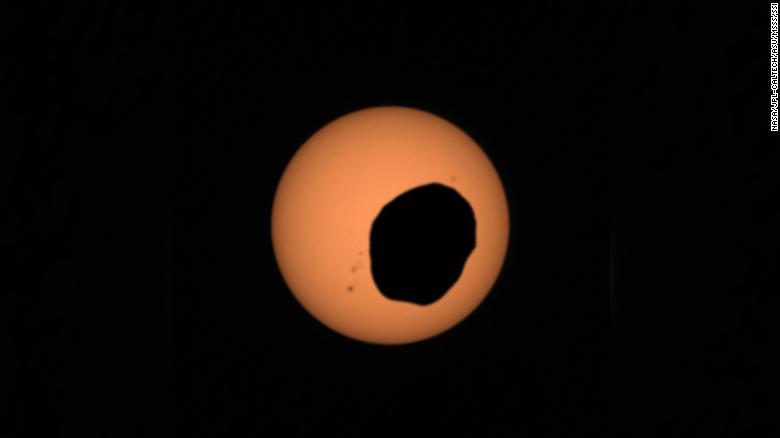Giant spiral storm at the north pole of Mars 0:46
(CNN) --
The Perseverance rover just witnessed a rare type of eclipse while perched on the surface of Mars, and its robotic rover captured video of it.
And although it seems that the rover saw the shadow of a potato cross the red surface of Mars, it is actually Phobos, one of the two small moons of Mars.
It was on April 2 that Perseverance observed the 40-second eclipse.
If this seems much shorter than a typical solar eclipse we see from Earth when our moon passes in front of the sun, that's because Phobos is about 157 times smaller than our moon.
The rover adds to an 18-year history of robots observing eclipses on Mars, which began with NASA's Spirit and Opportunity rovers in 2004 and was followed when Curiosity recorded the first video of a Martian eclipse in 2019.
What time does sunrise on Mars?
These new images reveal an early riser environment
Perseverance has provided the best video of this eclipse to date using the zoom capabilities of its mast-mounted camera system.
advertising
"I knew it was going to be good, but I didn't expect it to be this amazing," Rachel Howson, Mastcam-Z camera operator at Malin Space Science Systems in San Diego, said in a statement.
"It feels like a birthday or a holiday when it comes. You know what's coming, but there's an element of surprise left until you see the final product."
The video was also captured in color using a solar filter to reduce light intensity, allowing scientists to learn more about Phobos.
Watch the sunrise on Mars in new NASA images 1:04
"You can see details of Phobos's shadow outline, like ridges and bulges on the moonscape," Mark Lemmon, a planetary astronomer at the Space Science Institute in Boulder, Colorado, said in a statement.
"You can also see sunspots. And it's great that you can see this eclipse exactly as the rover saw it from Mars."
The tidal forces of Phobos's gravity pull on the Red Planet's crust and mantle, slightly deforming the Martian rock.
In turn, this gravitational force changes the orbit of Phobos.
Observations of the Phobos eclipse help scientists track how this moon's orbit changes over time, and better predict when it will come to an end.
Phobos is essentially doomed, advancing on its slow death spiral with each orbit, because it is constantly getting closer to the Martian surface.
Tens of millions of years from now, it will crash into Mars or break up into pieces that will rain down on Mars.
Perseverance and Ingenuity are almost imperceptible to the human eye from space
As scientists use eclipse observations to learn more about Phobos, the Perseverance rover has reached its next intriguing target: an ancient river delta in Jezero Crater.
The robotic explorer will collect samples from the fan-shaped rocks and also from sediments on the rim of the crater, which billions of years ago was created by a river flowing into a lake.
"The delta at Jezero Crater promises to be a true geological feast and one of the best places on Mars to look for signs of microscopic life from the past," Thomas Zurbuchen, associate administrator for NASA's Science Mission Directorate, said in a statement. .
"The answers are out there, and Team Perseverance is ready to find them."
Also, the Ingenuity helicopter just completed its 26th flight on the first anniversary of its first flight a year ago.
The helicopter will act as an aerial scout while Perseverance explores the delta.
eclipseMoonsMars

